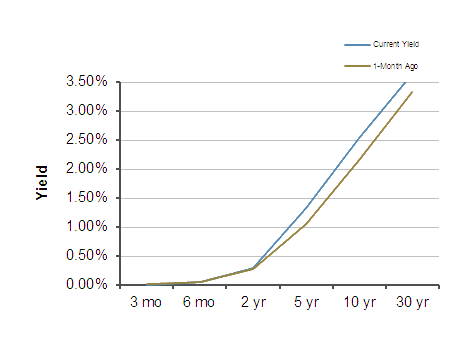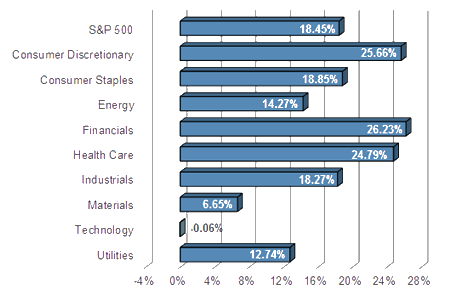
Market Commentary by Scott J. Brown, Ph.D., Chief Economist
 In his monetary policy testimony to Congress, Fed Chairman Bernanke said that “a highly accommodative monetary policy will remain appropriate for the foreseeable future.” He indicated that the Fed is using asset purchases “primarily to increase the near-term momentum of the economy, with the specific goal of achieving a substantial improvement in the outlook for the labor market.”
In his monetary policy testimony to Congress, Fed Chairman Bernanke said that “a highly accommodative monetary policy will remain appropriate for the foreseeable future.” He indicated that the Fed is using asset purchases “primarily to increase the near-term momentum of the economy, with the specific goal of achieving a substantial improvement in the outlook for the labor market.”
The Fed will rely on its forward guidance that short-term interest rates will continue to remain exceptionally low “to help maintain a high degree of monetary accommodation for an extended period after asset purchases end, even as the economic recovery strengthens and unemployment declines toward more normal levels.”Bernanke repeated that if the incoming economic data were to be broadly consistent with the Fed’s outlook, “we anticipate that it would be appropriate to begin to moderate the monthly pace of purchases later this year,” and if the subsequent data continued to confirm this pattern of ongoing economic improvement and normalizing inflation, “we expected to continue to reduce the pace of purchases in measured steps through the first half of next year, ending them around midyear.”
The economic data were mixed. The Beige Book note that “overall economic activity continued to increase at a modest to moderate pace” – the same phrase that was used in the two previous assessments. Retail sales rose 0.4% in June, but were flat ex-autos and up 0.1% excluding autos, building materials, and gasoline.
Industrial production rose 0.3%, with factory output up 0.3% (+1.8% y/y, but a -0.2% annual rate in 2Q12). The Consumer Price Index rose 0.3% in July (+1.8% y/y), boosted by a seasonal adjustment quirk in gasoline. For ex-food & energy, the CPI rose 0.2% (+0.161% before rounding, +1.6% y/y). Housing starts and building permits plunged, reflecting volatility in the multi-family sector, but single-family permits, the key figure in the report, rose 0.6%.
Next week, the economic calendar thins out. But don’t worry, the following week will more than make up for that. Higher mortgage rates may have had a minor impact on June home sales. Existing home sales measure closings and are more likely to reflect the previous month’s activity. New home sales measure initial transactions (deposit or signed contract), but the month changes are erratic and subject to large revisions. Aircraft orders should lead the durable goods figure.
Indices
| Last | Last Week | YTD return % | |
| DJIA | 15548.54 | 15460.92 | 18.65% |
| NASDAQ | 3611.28 | 3578.30 | 19.60% |
| S&P 500 | 1689.37 | 1675.02 | 18.45% |
| MSCI EAFE | 1731.42 | 1713.35 | 7.94% |
| Russell 2000 | 1050.27 | 1033.18 | 23.66% |
Consumer Money Rates
| Last | 1-year ago | |
| Prime Rate | 3.25 | 3.25 |
| Fed Funds | 0.10 | 0.17 |
| 30-year mortgage | 4.37 | 3.53 |
Currencies
| Last | 1-year ago | |
| Dollars per British Pound | 1.520 | 1.565 |
| Dollars per Euro | 1.309 | 1.227 |
| Japanese Yen per Dollar | 100.540 | 78.840 |
| Canadian Dollars per Dollar | 1.039 | 1.011 |
| Mexican Peso per Dollar | 12.540 | 13.112 |
Commodities
| Last | 1-year ago | |
| Crude Oil | 108.04 | 89.87 |
| Gold | 1285.09 | 1575.95 |
Bond Rates
| Last | 1-month ago | |
| 2-year treasury | 0.31 | 0.25 |
| 10-year treasury | 2.51 | 1.98 |
| 10-year municipal (TEY) | 4.48 | 3.74 |
Treasury Yield Curve – 07/19/2013
S&P Sector Performance (YTD) – 07/19/2013
Economic Calendar
| July 22nd |
— |
Existing Home Sales (June) |
| July 24th |
— |
New Home Sales (June) |
| July 25th |
— |
Jobless Claims (week ending July 20th) Durable Goods Orders (June) |
| July 30th |
— |
Consumer Confidence (July) |
| July 31st |
— |
ADP Payroll Estimate (July) Real GDP (advance 2Q13 + comprehensive revisions) FOMC Policy Decision (no press briefing) |
| August 1st |
— |
ISM Manufacturing Index (July) |
| August 2nd |
— |
Employment Report (July) |
Important Disclosures
US government bonds and treasury bills are guaranteed by the US government and, if held to maturity, offer a fixed rate of return and guaranteed principal value. US government bonds are issued and guaranteed as to the timely payment of principal and interest by the federal government. Treasury bills are certificates reflecting short-term (less than one year) obligations of the US government.
Commodities trading is generally considered speculative because of the significant potential for investment loss. Markets for commodities are likely to be volatile and there may be sharp price fluctuations even during periods when prices overall are rising. Specific sector investing can be subject to different and greater risks than more diversified investments.
Tax Equiv Muni yields (TEY) assume a 35% tax rate on triple-A rated, tax-exempt insured revenue bonds.
![]() Material prepared by Raymond James for use by its financial advisors.
Material prepared by Raymond James for use by its financial advisors.
The information contained herein has been obtained from sources considered reliable, but we do not guarantee that the foregoing material is accurate or complete. Data source: Bloomberg, as of close of business July 18th, 2013.
©2013 Raymond James Financial Services, Inc. member FINRA / SIPC.




